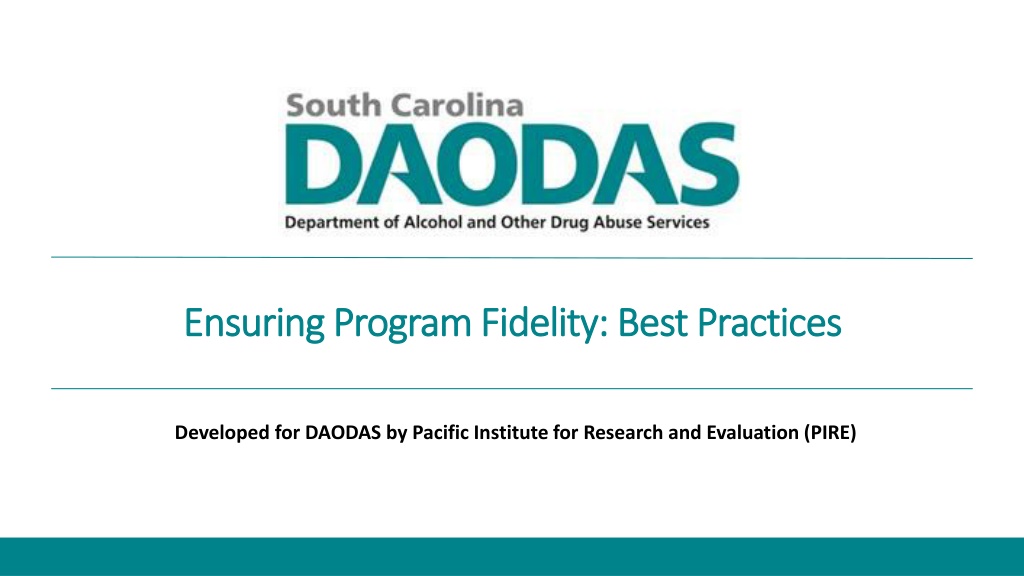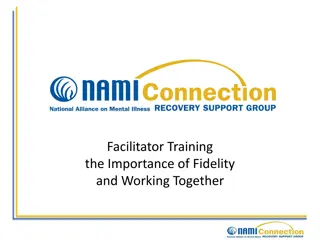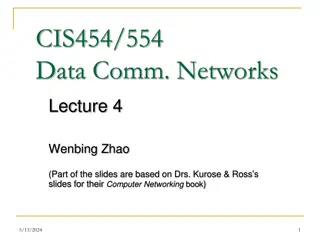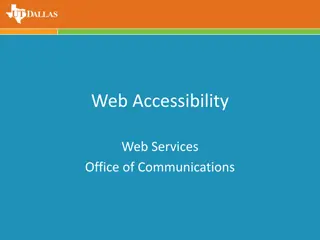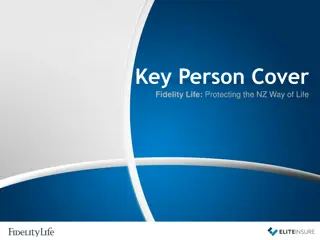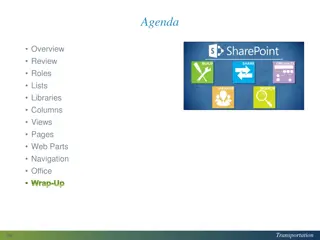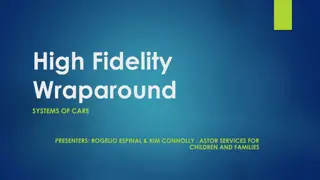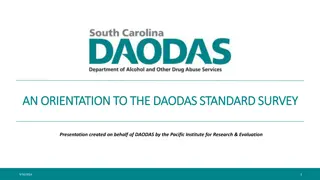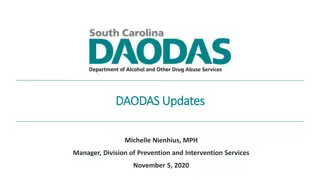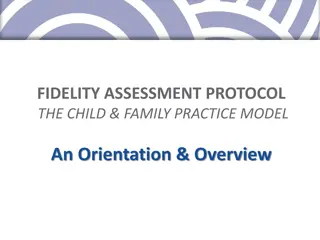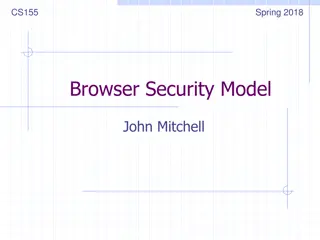Ensuring Program Fidelity: Best Practices for Prevention Providers
This resource explores best practices for ensuring program fidelity in substance abuse prevention, emphasizing the importance of understanding community needs, identifying evidence-based strategies, and delivering programs with fidelity. It discusses the significance of fidelity of implementation in improving outcomes and highlights components of program fidelity such as adherence, dosage, program quality, participant engagement, and program differentiation.
Download Presentation

Please find below an Image/Link to download the presentation.
The content on the website is provided AS IS for your information and personal use only. It may not be sold, licensed, or shared on other websites without obtaining consent from the author. Download presentation by click this link. If you encounter any issues during the download, it is possible that the publisher has removed the file from their server.
E N D
Presentation Transcript
Ensuring Program Fidelity: Best Practices Ensuring Program Fidelity: Best Practices Developed for DAODAS by Pacific Institute for Research and Evaluation (PIRE)
Todays Topics Today s Topics Introduction to Fidelity Adaptations Monitoring Fidelity Fidelity to Environmental Strategies
As prevention providers, what is in your control? As prevention providers, what is in your control? Knowledge of your community/target population and their needs. Identifying evidence-based strategies (programs, policies, practices) to meet those needs. Delivering those strategies with fidelity. Outcomes are not in your control. You can contribute to outcomes by delivering the most appropriate strategies to you community and delivering them well. You do not control outcomes (but you should still monitor them).
Fidelity of Implementation Fidelity of Implementation Definition: Fidelity of implementation is the degree to which teachers and other program providers implement programs as intended by the program developers. Research has shown that high fidelity to the program is associated with improved student outcomes. A high-quality implementation of a less promising program may be more effective than a low-quality implementation of a best practice program. Dusenbury, L., Brannigan, R., Falco, M., & Lake, A. (2004). An exploration of fidelity of implementation in drug abuse prevention among five professional groups. Journal of Alcohol and Drug Education, 47(3), 4-19.
Components of Program* Fidelity Components of Program* Fidelity Dane, A. V., & Schneider, B. H. (1998). Program integrity in primary and early secondary prevention: Are implementation effects out of control? Clinical Psychology Review, 18, 23 45. 1. Adherence 2. Dosage/Exposure/Duration 3. Quality of program delivery 4. Participant responsiveness/engagement 5. Program differentiation/specificity Ennett, S. T., Haws, S., Ringwalt, C. L., Vincus, A. A., Hanley, S., Bowling, J. M., & Rohrbach, L. A. (2011). Evidence-based practice in school substance use prevention: fidelity of implementation under real-world conditions. Health Education Research, 26(2), 361-371. doi:10.1093/her/cyr013. Gresham, F. M., Gansle, K. A., & Noell, G. H. (1993). Treatment integrity in applied behavior analysis with children. Journal of Applied Behavior Analysis, 26, 257 263. O Donnell, C. L. (2008). Defining, conceptualizing, and measuring fidelity of implementation and its relationship to outcomes in K 12 curriculum intervention research. Review of Educational Research, 78, 33 84. * We use the term program broadly to refer to a specific program, curriculum, intervention, or strategy.
Adherence Adherence How well did we stick to the program? Was the program delivered consistently across different teachers and settings? Did we deliver all the expected content? Did we use the format and materials identified by the program developers? Adherence is often used interchangeably with fidelity but is just one component of fidelity.
Dosage/Exposure/Duration Dosage/Exposure/Duration Does the schedule allow the program to be delivered for the recommended dosage/duration/frequency (e.g., are the number of sessions delivered consistent with the program plan)? Is the facilitator regularly available to support instruction? Is the participant regularly attending the program? Did any factors prevent the participant from receiving the intervention as intended? Dosage is often measured at the participant level, rather than at the session level.
Quality of Program Delivery Quality of Program Delivery Does the facilitator have the necessary training, knowledge, and skills to deliver the intervention correctly? Are quality teaching practices used consistently and with appropriate intensity across all sessions? Are different learning styles considered?
Participant Responsiveness/Engagement Participant Responsiveness/Engagement How attentive and involved are the participants in the program? This component of fidelity is least in your control. But you should pay attention to it and modify as needed. If you feel certain programs are not eliciting responsiveness, consider alternatives.
Program Differentiation/Specificity Program Differentiation/Specificity How well is the program defined and different from other programs? Was only one program delivered to participants at a time?
Numerous Factors Affect Implementation Fidelity Numerous Factors Affect Implementation Fidelity Community in which implementation occurs and the fit with the program Organization(s) responsible for implementation Program support systems (e.g., training and TA) Characteristics of providers Program participants James Bell Associates (2009, October). Evaluation brief: Measuring Implementation Fidelity. Arlington, VA: Author.
Adaptation: Fidelity Meets Reality Adaptation: Fidelity Meets Reality Some modifications to a program (intended or otherwise) will inevitably be made Some adaptation may be necessary and possibly beneficial, (e.g., the addition of an activity or a change in materials to address cultural context). Flexibility in implementation can also increase program ownership and involvement, thus resulting in longer program life.
Adaptation Adaptation The deliberate or unintentional modification of a program through: 1) deletions or additions (i.e., enhancements) to program components (e.g., to content, materials, activities); 2) modifications to the nature of the components; or 3) changes in the manner of administration or intensity (i.e., amount or duration) of program components.
Balance Between Fidelity and Adaptation Balance Between Fidelity and Adaptation Intervention developers may not have had opportunity to cover all local conditions. It may be beneficial even necessary to adapt programs to fit local conditions, cultures, or events (think COVID!) Adaptations should be thoughtful and justifiable (why is an adaptation necessary?) Adaptions are likely to be more successful if they add to the program rather than subtract from a program
Beware of Program Drift Beware of Program Drift In a study examining Life Skills Training, researchers found that while all teachers made adaptations, most were negative changes that detracted from curriculum objectives.
Easy as Pie (or Cake) Easy as Pie (or Cake) Implementing a program with fidelity is like baking a cake Follow the recipe, step by step Add ingredients in proper order Bake at the required temp and duration Adapt if warranted Your oven runs hot: cook at lower temp or shorter time Recipe includes nuts but someone has nut allergy: Skip the nuts Skipping the baking powder = poor outcome Extra chocolate is always good
Monitoring Fidelity/Program Monitoring Fidelity/Program Implementation Implementation You can only implement well (with fidelity) if you pay attention to it. Monitoring fidelity is as important as monitoring outcomes. (Why? Think about what you control.) The assessment of fidelity is particularly important when programs are implemented in real-world settings where program drift is common.
Why Should Fidelity Be Measured? Why Should Fidelity Be Measured? Program Planning, Management, and Improvement Provides a roadmap for implementation planning Identifies aspects of implementation that work well and don t work well Identifies barriers to implementation and ways to overcome them Provides feedback to facilitators/providers about aspects of implementation that work well and can be improved Evaluation Describes program implementation Helps explain why the program achieved expected outcomes and more important why it didn t? Helps explain variation in outcomes across sites.
Methods for Monitoring Fidelity* Methods for Monitoring Fidelity* Direct observations in person Direct observations via video recordings Facilitator self-assessments after each session Facilitator self-assessments after completing a program cohort (e.g., a classroom) Facilitator self-assessments after completing a larger program cycle (e.g., across multiple classrooms) * In descending order of resource intensity.
Tools for Monitoring Fidelity* Tools for Monitoring Fidelity* * The most comprehensive fidelity assessments will include all these tools.
Fidelity Checklist: Useful Tool for Assessing Fidelity Fidelity Checklist: Useful Tool for Assessing Fidelity Fidelity checklists are usually program specific Fidelity checklists include all the elements of a program that should be delivered Program developers often have fidelity checklists available that are specific for the programs In the absence of developer checklists, checklists can be created based on the content of the program
Fidelity Checklist (continued) Fidelity Checklist (continued) Ideally, use one checklist per program session Offers a reminder for steps in program implementation Some checklists may offer method to record necessary adaptation to program implementation Checklists can be used by observers or facilitators (self-assessments) Remember, fidelity checklists capture only some elements of fidelity.
Alternatives to Program Alternatives to Program- -Specific Fidelity Checklists Specific Fidelity Checklists Agencies may want to assess fidelity across multiple programs using the same tool (so program-specific checklists cannot be used) Generic fidelity questions can be used, such as Was all the program content of the delivered? Did the length of the sessions match that of the program guidance or curriculum? Did the frequency of delivery (sessions) match the guidance/curriculum? Were the sessions delivered in the same order as the guidance/curriculum? Were the materials or handouts the same as in the guidance/curriculum? Was the format of delivery the same as the original design (e.g., peer-led, interactive, lecture)? Were modifications made to the curriculum? Were participants engaged? Agencies must often balance specificity of measurement with pragmatic considerations
Monitoring Fidelity for Curriculum Monitoring Fidelity for Curriculum- -Based Programs vs. Environmental Strategies* Environmental Strategies* Many curriculum-based programs are scripted, have manuals, or provide extensive details about the elements of the program (high differentiation). Based Programs vs. In contrast, many environmental strategies do not provide such detailed guidance, making it hard to monitor fidelity. Nevertheless, fidelity can and should be assessed for environmental strategies. gatekeepers) in ways that discourage risky behaviors (or encourage healthy behaviors). They are often laws, policies, or regulations that need to be publicized and enforced. Examples include minimum age drinking laws, responsible beverage server training programs, and merchant compliance checks. * Environmental strategies modify and manage environments (or
Tips for Monitoring Fidelity for Environmental Strategies Tips for Monitoring Fidelity for Environmental Strategies Identify core components of an environmental strategy (search published literature and reports*) and commit to implementing them If information on core components is not available, ask the following questions to develop a list of core components: What partners are necessary to implement the strategy? What resources are necessary to implement the strategy? What steps are necessary to implement the strategy? Are there related elements that are critical for success (e.g., media and enforcement mechanisms) As with curriculum-based programs, monitor whether core components were implemented *PIRE has resources that identify the core components of many environmental strategies.
Final Thoughts Final Thoughts Implementing evidence-based programs with fidelity is a best practice Assessing fidelity is critical for implementing with fidelity (how do you know you did it if you do not pay attention to it?) Assessing fidelity is not a test or a gotcha moment it is a learning opportunity and helps ensure that we are delivering services in the most effective way Fidelity assessment is as important (probably more important) for program management and good service delivery than it is for evaluation purposes
Questions? Questions? 27 12/9/2024
1801 Main Street, 4th Floor Columbia, South Carolina 29201 telephone: 803-896-5555 fax: 803-896-5558 www.daodas.sc.gov 28 12/9/2024
